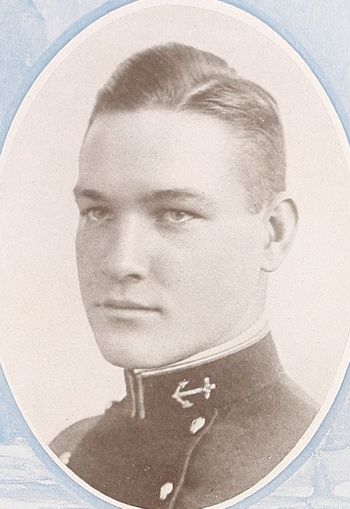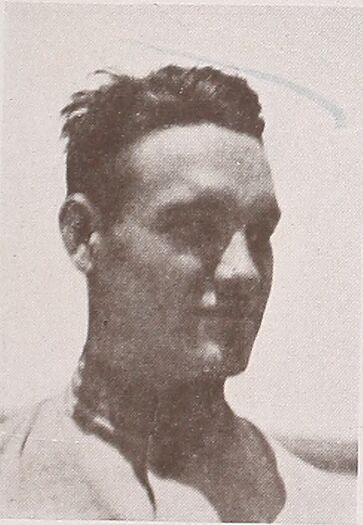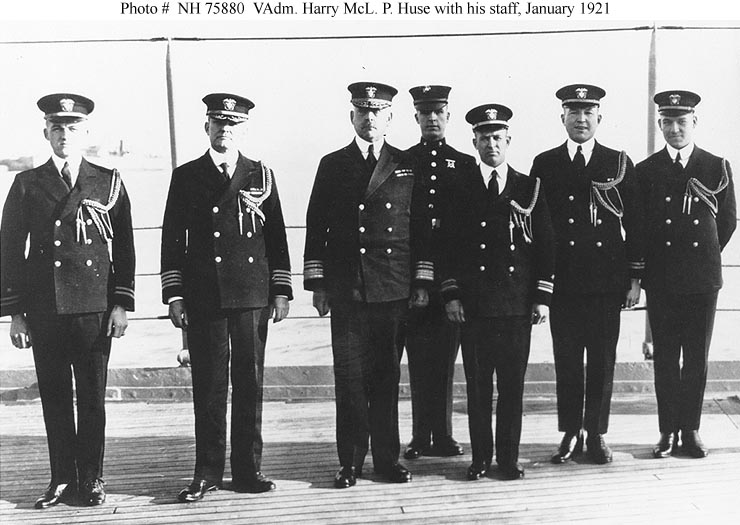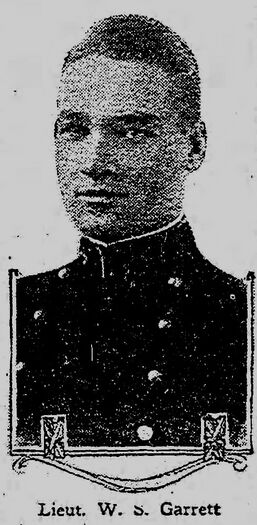WILLIAM S. GARRETT, LT, USN
William Garrett '18
Lucky Bag
From the 1918 Lucky Bag:
WILLIAM STURLENG GARRETT
Klamath Falls, Oregon
"Greek" "Orsatt Muencke"
YES, this our noble Greek, our Garrett! Why do we call him Greek? Oh, that is an easy question. It is because of his splendid physique, which indeed approaches the old Grecian ideals of manhood we so often see undraped in the marble. Why do we call him Orsatt? Well, that is a harder one. We could tell you easily enough, but we won't. However, if you really wish to know, just ask the Snapper.
The Greek is a tip-top athlete and a worker from the word "go." On the lacrosse team he was one of the mainstays, and anyone who makes good in that "savage" sport deserves credit. As a boxer he has a wicked punch and is just the same hard worker, with no little skill in addition. His bout with the scrappy Kenworthy, youngster year, will be remembered by all of us for a long time. And in football, this same Greek would have made his letter in another season, because he made good on the squad last fall.
He has done fairly well in studies, also, through his same predominating quality of giving all he has to the thing. Though not a "natural savoir," he has bluffed cold the Academic Department, and has pulled through with colors flying.
As a fusser, however, Greek does not shine! He is more at home with a lacrosse stick or a football than with a tea cup. It is Biesemier's delight to get Orsatt cornered before some girl and then get her to help him pay the victim pretty compliments. Our noble Greek blushes most beautifully, and his tongue verily cleaves to the roof of his mouth. Garrett is a true friend, a thoroughly likeable chap, level-headed, persistent, and cool, and he will make a most valuable addition to the Service.
"Hey, Fisher!"
Note—All the remainder of this man's famous sayings have been censored.
One Stripe; Football Numerals (2); Football Squad (2) Basketball Numerals (3); Lacrosse Squad (4, 3, 2); lNt
The Class of 1918 was graduated on June 28, 1917 due to World War I.

WILLIAM STURLENG GARRETT
Klamath Falls, Oregon
"Greek" "Orsatt Muencke"
YES, this our noble Greek, our Garrett! Why do we call him Greek? Oh, that is an easy question. It is because of his splendid physique, which indeed approaches the old Grecian ideals of manhood we so often see undraped in the marble. Why do we call him Orsatt? Well, that is a harder one. We could tell you easily enough, but we won't. However, if you really wish to know, just ask the Snapper.
The Greek is a tip-top athlete and a worker from the word "go." On the lacrosse team he was one of the mainstays, and anyone who makes good in that "savage" sport deserves credit. As a boxer he has a wicked punch and is just the same hard worker, with no little skill in addition. His bout with the scrappy Kenworthy, youngster year, will be remembered by all of us for a long time. And in football, this same Greek would have made his letter in another season, because he made good on the squad last fall.
He has done fairly well in studies, also, through his same predominating quality of giving all he has to the thing. Though not a "natural savoir," he has bluffed cold the Academic Department, and has pulled through with colors flying.
As a fusser, however, Greek does not shine! He is more at home with a lacrosse stick or a football than with a tea cup. It is Biesemier's delight to get Orsatt cornered before some girl and then get her to help him pay the victim pretty compliments. Our noble Greek blushes most beautifully, and his tongue verily cleaves to the roof of his mouth. Garrett is a true friend, a thoroughly likeable chap, level-headed, persistent, and cool, and he will make a most valuable addition to the Service.
"Hey, Fisher!"
Note—All the remainder of this man's famous sayings have been censored.
One Stripe; Football Numerals (2); Football Squad (2) Basketball Numerals (3); Lacrosse Squad (4, 3, 2); lNt
The Class of 1918 was graduated on June 28, 1917 due to World War I.
Loss
William was lost on February 18, 1925 when the aircraft he was piloting crashed near Yuma, Arizona.
Other Information
From researcher Kathy Franz:
William’s plane, a D Avalon 2-2 (De Haviland,) was one of six that were on a survey and photographic flight from the San Diego station. The De Havilands, known among fliers as “flaming coffins” were known to catch fire during a crash. William’s death was the first in the Navy, but several other Army fliers died in other crashes. Nine days later, the Navy discarded 25 De Haviland planes and substituted Vaught observation planes.
Others pilots that day were: LCDR Millington McComb '10, LT T. C. Longquist, LT Valentine Hixson Schaeffer ('19,) LT M. S. Eligman, and LT Samuel Arthur '20.
William’s body was prepared for shipment to San Diego and buried in Forest Lawn Cemetery in Los Angeles.
In 1900, the family lived in Fort Wrangel in the Alaska Territory. His father John was a saloon keeper, but when he lived in Topeka, Kansas, he was a farmer. William’s birth was noted as September, 1896. His father went to Alaska in February, 1898, and the rest of the family came in August.
In May 1914, William was appointed to the Naval Academy by Representative Sinnott. In the Klamath Union High School’s 1914 yearbook, William was listed as Sturling, a junior. The Kids call him: Tady.” Noted for: Athletic ability. Favorite Expression: “A’int that so?” Fate: Lion tamer. William played guard in basketball and earned a letter that year.
In 1920 the family was in Klamath. His father and brother Glenn were contractors moving dirt. In November, the family filed articles for the establishment of John H. Garrett & Son, Inc., capitalization, $75,000.
His father was John H. Garrett, and his mother was Hettie/Hattie. She came to Los Angeles in 1921. His brothers were Dr. Glenn B. of Portland and John Clifford, the founder and chairman of the board of the Garrett Corp. William was survived by his uncles C. D. Cunningham, attorney in Centralia, Washington, and Guy Cunningham of Auburn, Kansas.
From The Morning Sun (Yuma, Arizona) on February 19, 1925:
Making too short a turn preparatory to landing at the Yuma aviation field yesterday, shortly before noon, Lieut. W.S. Garrett, piloting plane D Avalon 2-2 in which was Mechanic Chris A. Funk, dropped 150 feet to his death, he being nearly cremated in the resulting blast of flame which shot from the broken gasoline tank, Funk jumping from the plane just before it landed, and though badly burned, his life was saved.
Funk's escape was nothing short of a miracle. When the plane nosed down in a tail spin he threw himself sideways, from the aircraft, falling twenty feet away from the machine, but the explosion of the gas tank poured the blazing gasoline over his face and hands and legs, and by rolling away from the plane in the send he obliterated the flame.
Norman C. Conway, engineer of Yuma, a friend of Lieut. Commander Ralph Wood of the visiting squadron of six airplanes from San Diego, reached Funk first, and after hasty attention to his burns he was rushed to the Yuma hospital, where he received prompt and careful attention at the hands of Dr. W.C. Cain and the nursing staff of the institution.
Never a Chance
It was impossible for any of Garrett's comrades to attempt a rescue, which would have been fruitless, for he must have died almost instantly, and when the flames had subsided he was lying outside the cockpit of the plane a mere shape of a man. The tail and a blade of propellor were all that was left of the perishable parts of the plane, and even the metal parts were twisted and melted into an unrecognizable mass.The the members of the squadron rushed the 300 yards that separated their unfortunate companion from the remainder of the escadrille, and though attempts were made to throw sand on the fiercely blazing aircraft, it was eaten up by the hungry element before their endeavors had any effect, and realizing the hopelessness of their task, all attention was concentrated on relieving Funk of his agony.
…
Commander's Opinion
In Lieut. Commander Ralph Wood's testimony it was shown that the deceased aviator was a skilled pilot, of three years' training, and that on attempting to land on the field the first time Garrett crossed north to south the narrower of the two ways, and in all probability finding that his speed was too great to pull up in the prescribed area, rose again and circled.At the west end of the ground, and still in the circle the plane banked sharply to the left, spun round in a downward direction, and crashed, a column of smoke immediately leaping up from the spot following the sound of a loud report.
He is buried, without any mention of rank or service on his headstone, in California. Note the date of birth on the headstone (1897) is at odds with that in the Register of Commissioned and Warrant Officers of the United States Navy and Marine Corps of 1918 and the Naval Academy Registers during his time there, which both have 1896.
Photographs
"Vice Admiral Harry McL. P. Huse, USN, Commander, U.S. Forces in European Waters. With members of his staff, January 1921. Those present are (from left to right): Lieutenant Moses B. Byington, Jr; Captain David W. Todd; Vice Admiral Huse; unidentified Marine orderly; Lieutenant Commander Lucius C. Dunn; Lieutenant James C. Bequette; and Lieutenant William S. Garrett. The border of the original print is inscribed: "To Mrs. W.V. Pratt from her cousin Harry P. Huse, Vice Admiral, U.S.N." Courtesy of the Naval Historical Foundation. Collection of Admiral William V. Pratt, USN."
Service
William was aboard the gunboat USS Sacramento (PG 19) in 1917.
In June 1923 he was detached from USS Pennsylvania to Naval Air Station Pensacola, Florida.
"W.S. Garrett" earned his wings as naval aviator #3116 on January 11, 1924.
Related Articles
Millington McComb '10 and Samuel Arthur '20 were also members of this squadron.
The "Register of Commissioned and Warrant Officers of the United States Navy and Marine Corps" was published annually from 1815 through at least the 1970s; it provided rank, command or station, and occasionally billet until the beginning of World War II when command/station was no longer included. Scanned copies were reviewed and data entered from the mid-1840s through 1922, when more-frequent Navy Directories were available.
The Navy Directory was a publication that provided information on the command, billet, and rank of every active and retired naval officer. Single editions have been found online from January 1915 and March 1918, and then from three to six editions per year from 1923 through 1940; the final edition is from April 1941.
The entries in both series of documents are sometimes cryptic and confusing. They are often inconsistent, even within an edition, with the name of commands; this is especially true for aviation squadrons in the 1920s and early 1930s.
Alumni listed at the same command may or may not have had significant interactions; they could have shared a stateroom or workspace, stood many hours of watch together… or, especially at the larger commands, they might not have known each other at all. The information provides the opportunity to draw connections that are otherwise invisible, though, and gives a fuller view of the professional experiences of these alumni in Memorial Hall.
March 1918
January 1919
January 1922
May 1923
July 1923
September 1923
November 1923
January 1924
March 1924
May 1924
July 1924
September 1924
January 1925

The "category" links below lead to lists of related Honorees; use them to explore further the service and sacrifice of alumni in Memorial Hall.


